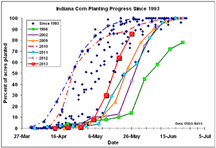Indiana farmers now ahead of five-year pace in planting crops
May 29, 2013
 |
|
This chart, based on data from the U.S.
Department of Agriculture's National Agricultural Statistics Service, shows the
progress of corn planting in Indiana, highlighting key years since 1993.
(Purdue Department of Agronomy graphic/Bob Nielsen)
|
WEST LAFAYETTE, Ind. - Indiana farmers who a month ago were wondering when they would get a break from rain to work their fields continued to take advantage of May weather opportunities, surging ahead of the five-year average pace in planting corn and soybeans.
Despite cool temperatures and intermittent rain last week, farmers had planted 86 percent of the intended corn acreage as of the week ending May 26, the U.S. Department of Agriculture's National Agricultural Statistics Service said. That put farmers ahead of the five-year average - 77 percent - for the first time following weeks of planting delays from frequent and heavy rains in April.
It wasn't only the weather that enabled farmers to catch up so quickly; larger equipment, including planters, used today allows for faster planting, noted Bob Nielsen, Purdue Extension corn specialist.
"The combination of favorable soil conditions and today's high-capacity field equipment allowed Indiana corn growers to plant 78 percent of the state's corn crop during the past three weeks," he said.
Fifty-six percent of the corn had emerged, slightly below the five-year average of 59 percent.
Soybean farmers planted 60 percent of the crop by May 26, compared with the five-year average of 49 percent. Soybeans typically are planted after corn.
Twenty-four percent of the soybean crop had emerged, compared with the five-year average of 30 percent.
For Indiana's wheat crop, the cool, wet spring slowed its maturation, the NASS said. But there were few reports of disease or insect problems.
Hay was ready to cut throughout the state, the NASS said, although the constant threat of rain made it difficult for farmers to get the crop baled and into their barns without it getting wet.
The NASS said most of the fruit and berry crops will make it through the bloom stage this year with little damage from frost.
Writer: Keith Robinson, 765-494-2722, robins89@purdue.edu
Source: Bob Nielsen, 765-494-4802, rnielsen@purdue.edu
Related websites:
Purdue
Department of Agronomy
The
Chat ‘n Chew Café
Ag Communications: (765) 494-2722;
Keith Robinson, robins89@purdue.edu
Agriculture News Page

